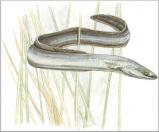Eel - Anguilla anguilla
This snake-like fish (its body can be 2 metres long and weigh as much as 6kg) feeds on aquatic invertebrates, amphibians, other fish and their eggs. It is rarely taken by mammals or carnivorous fish because its blood contains a poison (ichthyotoxin) which affects the nervous system - it can even be dangerous to humans if they come into contact with it through cuts or wound on the skin.
The Eel is an "euryhaline" fish, which means it can tolerate considerable differences in salinity and so can live in both fresh and sea water; this peculiarity is linked to its famous migratory behaviour.
The Eel spawns in the Sargasso Sea in the middle of the Atlantic Ocean (according to some ichthylogists in the Mediterranean Sea too); the adults die, but their larvae, ("Leptocephalus") slowly migrate eastwards and after 2-3 years reach the European coasts.
Here they begin to change into eel-shaped Elvers and at this point ascend the rivers, a phenomenon which brings them into the Italian wetlands.
During their second European winter, the Elvers grow into sub-adults ("Yellow Eels ") up to 20 cm long. After 4-5 years they finally become adults, "Silver Eels", and begin their return to the sea to complete their life cycle.
The Eel has played an important economical role in history, especially at the Fucecchio marshes.
During Medicean times, huge nets were laid across the watergates at Cappiano Bridge to catch enormous hauls of eels as they made their way back to the Arno to reach the sea, via the Usciano Canal.




